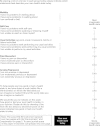The application of different appendicular skeletal muscle cutoff points and research definitions associated with health-related quality of life in Korean older people: data from KNHANES 2008-2011
- PMID: 25535336
- PMCID: PMC4289545
- DOI: 10.1186/1471-2318-14-144
The application of different appendicular skeletal muscle cutoff points and research definitions associated with health-related quality of life in Korean older people: data from KNHANES 2008-2011
Abstract
Background: This study was conducted to determine the prevalence of a low appendicular skeletal muscle index (ASMI) using three cut-off points (mean ASMI-2SD of a gender-specific young reference group (aged 18-39 years), mean ASMI-1SD of a gender-specific young reference group, and the lower 20 percentile value of a gender-specific older group (aged ≥ 65 years)) in Korean older people and the relationship between ASMI and subjective health-related quality of life.
Methods: This study utilized data acquired during the Korean National Health and Nutrition Examination Survey (KNHANES) from 2008-2011. Dual-energy X-ray absorptiometry body compositional data was obtained from a subsample of 6538 subjects (men 2804, women 3734) aged 18-39 and 4413 subjects (men 1872, women 2541) aged 65 years and older. The three definitions of low appendicular skeletal muscle and the EQ-5D-3 L-Korean descriptive system were applied to Korean older people.
Results: For the ASMI cutoff points used, in men, the three cutoff points were ASMI 2SD (6.09 kg/m2), ASMI 20 (6.48 kg/m2), and ASMI 1SD (6.95 kg/m2). In women, ASMI 2SD (4.38 kg/m2) was the lowest, followed by ASMI 1SD (4.96 kg/m2) and ASMI 20 (5.33 kg/m2). Proportions of older subjects with a low ASMI using the three cutoff points were 9.7% (ASMI 2SD) and 40.9% (ASMI 1SD) in men, and 0.7% (ASMI 2SD) and 7.4% (ASMI 1SD) in women. By multivariate ordinal logistic regression analysis, men with a low ASMI had significantly high odd ratios for the three domains of mobility (p < 0.001), self-care (p = 0.005), and usual activities (p = 0.004) among the five domains of the EQ-5D and EQ-5D index (p = 0.010).
Conclusions: The ASMI 2SD cut-off points for older Koreans, 6.09 kg/m2 for men and 4.38 kg/m2 for women, resulted in low prevalences of a low ASM, that is, 9.7% for men and 0.7% for women, and showed low clinical usefulness due to very low determined prevalence in women. Hence, we suggest that the cut-off point of the lowest 20% of Korean older people (men: 6.48 kg/m2, women; 5.33 kg/m2) be used for older Koreans.
Figures
Similar articles
-
The relationship of physical activity (PA) and walking with sarcopenia in Korean males aged 60 years and older using the Fourth Korean National Health and Nutrition Examination Survey (KNHANES IV-2, 3), 2008-2009.Arch Gerontol Geriatr. 2013 May-Jun;56(3):472-7. doi: 10.1016/j.archger.2012.12.009. Epub 2013 Jan 6. Arch Gerontol Geriatr. 2013. PMID: 23298535
-
Type 2 diabetes is associated with low muscle mass in older adults.Geriatr Gerontol Int. 2014 Feb;14 Suppl 1:115-21. doi: 10.1111/ggi.12189. Geriatr Gerontol Int. 2014. PMID: 24450569
-
Ethnic-specific cut-points for sarcopenia: evidence from black South African women.Eur J Clin Nutr. 2015 Jul;69(7):843-9. doi: 10.1038/ejcn.2014.279. Epub 2015 Jan 21. Eur J Clin Nutr. 2015. PMID: 25604775
-
Sarcopenia: Prevalence and associated factors based on different suggested definitions in community-dwelling older adults.Geriatr Gerontol Int. 2016 Mar;16 Suppl 1:110-22. doi: 10.1111/ggi.12723. Geriatr Gerontol Int. 2016. PMID: 27018289 Review.
-
Differences among skeletal muscle mass indices derived from height-, weight-, and body mass index-adjusted models in assessing sarcopenia.Korean J Intern Med. 2016 Jul;31(4):643-50. doi: 10.3904/kjim.2016.015. Epub 2016 Jun 22. Korean J Intern Med. 2016. PMID: 27334763 Free PMC article. Review.
Cited by
-
Selecting Appropriate Sarcopenia Screening Methods for Asian Populations.J Clin Med. 2020 Jul 22;9(8):2333. doi: 10.3390/jcm9082333. J Clin Med. 2020. PMID: 32707874 Free PMC article.
-
Body composition and changes in health-related quality of life in older age: a 10-year follow-up of the Helsinki Birth Cohort Study.Qual Life Res. 2020 Aug;29(8):2039-2050. doi: 10.1007/s11136-020-02453-1. Epub 2020 Mar 2. Qual Life Res. 2020. PMID: 32124264 Free PMC article.
-
Appendicular Skeletal Muscle Mass Reference Values and the Peak Muscle Mass to Identify Sarcopenia among Iranian Healthy Population.Int J Prev Med. 2018 Mar 9;9:25. doi: 10.4103/ijpvm.IJPVM_295_17. eCollection 2018. Int J Prev Med. 2018. PMID: 29619149 Free PMC article.
-
New criteria of the Asian working group for sarcopenia: High prevalence of severe sarcopenia in hospitalized patients.Medicine (Baltimore). 2025 Mar 14;104(11):e41912. doi: 10.1097/MD.0000000000041912. Medicine (Baltimore). 2025. PMID: 40101027 Free PMC article.
-
What is the best adjustment of appendicular lean mass for predicting mortality or disability among Japanese community dwellers?BMC Geriatr. 2018 Jan 5;18(1):8. doi: 10.1186/s12877-017-0699-6. BMC Geriatr. 2018. PMID: 29304751 Free PMC article.
References
-
- Cruz-Jentoft AJ, Baeyens JP, Bauer JM, Boirie Y, Cederholm T, Landi F, Martin FC, Michel JP, Rolland Y, Schneider SM, Topinkova E, Vandewoude M, Zamboni M. Sarcopenia: European consensus on definition and diagnosis: report of the European working group on sarcopenia in older people. Age Ageing. 2010;39(4):412–423. doi: 10.1093/ageing/afq034. - DOI - PMC - PubMed
-
- Fielding RA, Vellas B, Evans WJ, Bhasin S, Morley JE, Newman AB, Abellan Van Kan G, Andrieu S, Bauer J, Breuille D, Cederholm T, Chandler J, Meynard CD, Donini L, Harris T, Kannt A, Guibert FK, Onder G, Papanicolaou D, Rolland Y, Rooks D, Sieber C, Souhami E, Verlaan S, Zamboni M. Sarcopenia: an undiagnosed condition in older adults. Current consensus definition: prevalence, etiology, and consequences. International working group on sarcopenia. J Am Med Assoc. 2011;12(4):249–256. doi: 10.1016/j.jamda.2011.01.003. - DOI - PMC - PubMed
-
- Rosenberg IH. Summary comments. Am J Clin Nutr. 1989;50(5):1231–1233.
Pre-publication history
-
- The pre-publication history for this paper can be accessed here:http://www.biomedcentral.com/1471-2318/14/144/prepub
MeSH terms
LinkOut - more resources
Full Text Sources
Other Literature Sources
Medical


